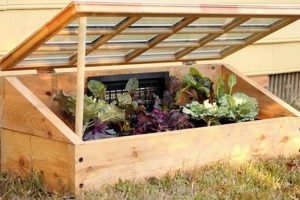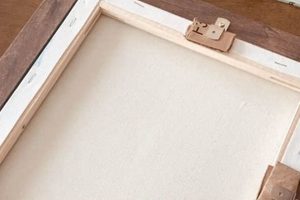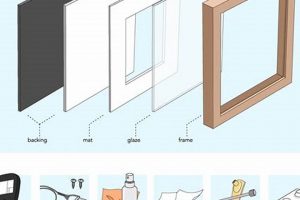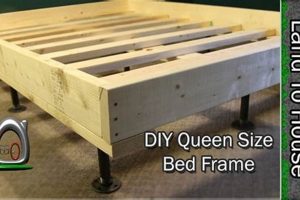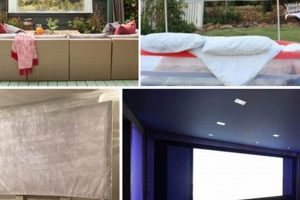The subject involves constructing a decorative border for a television, typically designed to resemble a picture frame. This allows the television to better integrate into the room’s aesthetic when not in use, transforming it from a black rectangle into something more visually appealing. An example would be building a wooden structure that fits around the television screen, concealing the bezel and adding a decorative element.
Constructing this type of enhancement offers several advantages, including cost savings compared to purchasing pre-made framed televisions. It also provides opportunities for customization, allowing the creator to select materials, colors, and designs that perfectly complement the existing dcor. Historically, this approach reflects a broader trend of personalizing electronic devices to better align with individual tastes and interior design preferences, moving away from purely functional objects towards integrated aesthetic elements.
Subsequent sections will delve into the specifics of material selection, construction techniques, mounting options, and design considerations relevant to undertaking such a project, providing a guide for those interested in enhancing their television’s appearance.
Essential Guidance for Constructing a Television Surround
The following points provide crucial guidance for those undertaking the creation of a decorative surround for a television. Attention to these details will improve the final product and ensure longevity.
Tip 1: Precise Measurement is Critical: Accurate dimensions of the television are essential. Measure the screen’s viewable area and the outer bezel dimensions. Incorrect measurements can lead to a poorly fitting surround, compromising the aesthetic and potentially interfering with the television’s functionality.
Tip 2: Material Selection Impacts Durability: Consider the weight and stability of the chosen material. Lightweight wood, such as pine or MDF, is commonly used. Heavier materials require more robust mounting solutions and may pose a risk of damage to the television or the wall it is mounted on.
Tip 3: Ventilation Must Be Maintained: Televisions generate heat. Ensure the surround design incorporates adequate ventilation to prevent overheating. Strategically placed openings at the top and bottom of the surround will facilitate airflow.
Tip 4: Mounting Solutions Require Careful Planning: Determine the mounting method before construction begins. If the surround is to be attached directly to the television, use non-adhesive materials and a secure but reversible attachment system. If wall mounting, ensure the surround does not obstruct access to mounting points or add excessive weight to the wall mount.
Tip 5: Finishing Techniques Enhance Appearance: Proper finishing adds to the overall aesthetic. Sand all surfaces smooth before applying paint, stain, or other decorative finishes. Multiple coats of a protective sealant will prolong the life of the surround.
Tip 6: Cord Management Promotes a Clean Look: Integrate cord management solutions into the surround design. Conceal cords within the structure or provide channels for discreet routing, minimizing visual clutter.
Attention to detail and careful planning are paramount. Selecting appropriate materials, maintaining adequate ventilation, and ensuring secure mounting will contribute to a successful project.
Following sections will address advanced design options and troubleshooting common challenges encountered during construction.
1. Material Selection
Material selection constitutes a foundational element in the creation of a decorative surround for a television. The chosen materials directly influence the structural integrity, aesthetic appeal, and functional performance of the completed “diy frame tv frame”. Inappropriate material selection can result in a frame that is structurally unstable, aesthetically incongruous with the surrounding environment, or that negatively impacts the television’s operation. For instance, utilizing excessively heavy materials without adequate support structures can pose a risk of detachment or damage to the television. Conversely, selecting materials that are too flimsy may result in a frame that warps or breaks over time, diminishing its visual appeal and potentially exposing the television’s bezel.
The impact of material choice extends beyond mere structural considerations. The type of material dictates the finishing options available, influencing the frame’s ability to seamlessly integrate with the existing room dcor. For example, solid wood allows for a wide range of staining and painting possibilities, enabling precise color matching and the creation of custom finishes. Medium-density fiberboard (MDF) provides a smooth surface ideal for painting but may not offer the same visual depth or tactile quality as natural wood. Furthermore, the material’s thermal properties are relevant, particularly regarding ventilation. Materials that retain heat excessively could exacerbate temperature concerns around the television, potentially shortening its lifespan. A practical consideration is the ease of workability; materials like softwood are more amenable to cutting and shaping with standard tools, reducing construction complexity.
In summary, material selection is not merely a cosmetic decision but a critical engineering consideration. Thoughtful evaluation of weight, structural properties, finishing capabilities, and thermal characteristics is essential to realizing a “diy frame tv frame” that is both visually pleasing and functionally sound. Addressing these factors proactively mitigates potential risks and enhances the long-term viability of the project.
2. Construction Techniques
The methods employed in assembling the frame significantly influence its structural integrity, aesthetic presentation, and overall functionality. Appropriate techniques ensure the frame is both visually appealing and capable of withstanding the stresses of installation and use, enhancing the lifespan of the “diy frame tv frame”.
- Joinery Methods
The selection of joinery techniques, such as mitered corners, butt joints, or rabbet joints, directly affects the frame’s stability and visual appeal. Mitered corners, when properly executed, offer a clean, professional look but require precise cuts and secure fastening. Butt joints are simpler to execute but may necessitate reinforcement with dowels or screws. The chosen joinery method must align with the material properties and the desired aesthetic.
- Fastening Methods
The method of securing the frame components, whether through screws, nails, glue, or a combination thereof, is crucial for long-term durability. Screws provide a stronger, more reliable connection than nails, particularly when used in conjunction with wood glue. The type of glue used should be appropriate for the material, ensuring a strong bond that resists moisture and temperature changes. Proper clamping during the glue drying process is essential to maintain alignment and maximize adhesion.
- Cutting and Shaping Precision
Accurate cutting and shaping of the frame components are paramount to achieving a seamless fit and a professional appearance. Utilizing precision cutting tools, such as a miter saw or table saw, ensures that angles are accurate and edges are smooth. Proper sanding techniques are necessary to eliminate imperfections and prepare the surface for finishing. Inaccuracies in cutting and shaping can result in gaps, misalignments, and an overall unprofessional appearance.
- Finishing Application
The application of finishes, such as paint, stain, or varnish, not only enhances the frame’s aesthetic appeal but also protects the material from moisture and wear. Proper surface preparation, including sanding and priming, is essential for achieving a smooth, even finish. Multiple coats of finish may be necessary to achieve the desired level of protection and visual depth. The chosen finish should be compatible with the material and the intended use environment.
The successful implementation of these construction techniques is essential to realizing a visually appealing and structurally sound “diy frame tv frame”. Careful attention to detail and adherence to established woodworking principles will contribute to a finished product that enhances the television’s appearance and integrates seamlessly into the surrounding environment.
3. Mounting Stability
Mounting stability represents a critical consideration in the design and implementation of a “diy frame tv frame.” The security and integrity of the mounting system directly impact the safety of the television and the longevity of the frame itself. A poorly designed or executed mounting solution can lead to instability, posing risks of damage or injury.
- Weight Distribution
Effective mounting necessitates an understanding of weight distribution. The frame adds to the television’s overall weight, potentially exceeding the capacity of existing wall mounts or stands. Improper weight distribution can create stress points, leading to mount failure or damage to the television’s housing. Consideration must be given to the frame’s material, dimensions, and construction method to ensure balanced weight distribution across the mounting points. For example, a frame constructed from heavy wood requires a more robust mounting system than one made from lightweight material.
- Attachment Method
The method by which the frame is attached to the television is paramount. Direct attachment requires a secure and non-damaging system that does not interfere with the television’s operation or ventilation. Alternatives include a separate mounting system for the frame that surrounds the television without direct contact. The chosen method should account for the television’s VESA mounting pattern and the frame’s dimensions, ensuring compatibility and stability. Adhesive-based attachment methods should be approached with caution due to potential long-term adhesion issues and the risk of damage during removal.
- Wall Mount Compatibility
For wall-mounted televisions, the frame’s design must be compatible with the existing wall mount. The added weight and dimensions of the frame can affect the mount’s load capacity and range of motion. It is crucial to verify that the wall mount is rated to support the combined weight of the television and frame. Additionally, the frame should not obstruct access to the mount’s adjustment mechanisms or cable connections. A frame that interferes with the wall mount’s functionality can compromise its stability and usability.
- Material Integrity of Mounting Points
Whether attaching the frame to the TV itself or to the wall, the integrity of the mounting points is paramount. Weak materials or poorly constructed joints at these points can lead to failure under stress. Reinforcing these areas with metal brackets, robust screws, and high-strength adhesives can mitigate this risk. For wall-mounted systems, ensuring that the mounting hardware is securely anchored to wall studs is crucial for preventing the entire assembly from detaching from the wall. Neglecting the material integrity of mounting points can result in catastrophic failure, potentially damaging the television and creating a safety hazard.
In conclusion, mounting stability is an indispensable aspect of creating a “diy frame tv frame.” Careful consideration of weight distribution, attachment method, wall mount compatibility, and material integrity is essential for ensuring a safe and aesthetically pleasing installation. A well-engineered mounting system not only protects the television and frame but also contributes to the overall visual appeal and functionality of the setup.
4. Aesthetic Integration
Aesthetic integration, in the context of a “diy frame tv frame,” refers to the degree to which the finished product harmonizes with the existing design elements of the room. The primary purpose of constructing a decorative surround is often to mitigate the stark visual impact of a television screen when not in use, transforming it from a dominant technological element into a more subtle and aesthetically pleasing component of the interior. Therefore, the success of a frame hinges on its ability to seamlessly blend with the surrounding decor, enhancing rather than detracting from the room’s overall ambiance. A frame that clashes with the room’s color scheme, architectural style, or furniture design would fail to achieve its intended purpose, diminishing the aesthetic value of the space.
Achieving effective aesthetic integration requires careful consideration of several factors. These include selecting materials and finishes that complement existing furniture and architectural details. For instance, in a room with a rustic aesthetic, a frame constructed from reclaimed wood with a distressed finish would be more appropriate than a sleek, modern frame made of metal or glass. Similarly, in a room with a predominantly neutral color palette, the frame can serve as a subtle accent piece, adding a touch of color or texture without overwhelming the space. Furthermore, the frame’s design should take into account the television’s placement and viewing angle. A frame that is too large or ornate can distract from the viewing experience, while a frame that is too small or simple may fail to adequately conceal the television’s bezel.
In summary, aesthetic integration is an indispensable aspect of constructing a “diy frame tv frame.” By carefully considering the room’s design elements and selecting materials and finishes that complement the existing decor, it is possible to create a frame that enhances the aesthetic appeal of the space and transforms the television into a more harmonious component of the interior. The challenge lies in balancing the desire to create a visually striking frame with the need to maintain a cohesive and balanced aesthetic.
5. Ventilation Consideration
Ventilation consideration forms a critical component in the design and implementation of a “diy frame tv frame,” directly impacting the operational longevity and performance of the enclosed television. Insufficient ventilation can lead to elevated internal temperatures, potentially causing component degradation, reduced lifespan, and, in extreme cases, device malfunction. Therefore, the integration of adequate ventilation strategies is paramount.
- Passive Airflow Dynamics
Passive airflow systems rely on natural convection to dissipate heat. This involves incorporating strategically positioned vents at the top and bottom of the frame, allowing cooler air to enter from below and warmer air to exit from above. The effectiveness of passive airflow depends on the size and placement of vents, as well as the ambient temperature of the room. For instance, a frame with small, poorly placed vents in a warm environment may not provide sufficient cooling, leading to heat buildup. Implementation must consider the natural movement of air and the device’s typical operating temperature.
- Active Cooling Integration
Active cooling employs mechanical components, such as small fans, to enhance airflow. These fans can be strategically positioned to draw cool air into the frame or expel hot air, providing a more consistent and controlled cooling effect. Active cooling is particularly useful in situations where passive airflow is insufficient or where the television generates significant heat. A practical example would be integrating a low-noise fan at the top of the frame to exhaust hot air, coupled with vents at the bottom to draw in cooler air. However, active cooling introduces additional complexity and requires a power source.
- Material Thermal Properties
The thermal properties of the materials used in constructing the frame play a role in heat management. Certain materials, such as wood, act as insulators, trapping heat within the enclosure. Conversely, materials like metal can dissipate heat more effectively. Selecting materials with appropriate thermal properties can help to regulate the internal temperature of the frame. An example of this would be using a thin layer of heat-conductive material on the interior surfaces of the frame to draw heat away from the television and dissipate it more effectively.
- Environmental Considerations
External environmental factors, such as room temperature and humidity, influence the effectiveness of ventilation strategies. In warmer climates or poorly ventilated rooms, the frame’s internal temperature may rise more rapidly, necessitating more robust cooling solutions. Conversely, in cooler environments, passive airflow may be sufficient. Consideration must also be given to humidity levels, as excessive moisture can damage electronic components. The implementation of ventilation strategies should be tailored to the specific environmental conditions in which the television is operating.
These interconnected facets of ventilation consideration highlight its indispensable role in the successful construction and operation of a “diy frame tv frame.” Addressing these factors proactively ensures optimal performance and longevity of the enclosed television, preventing potential issues related to overheating and component degradation. Prioritizing effective ventilation contributes to a more reliable and aesthetically pleasing integration of the television into the living space.
Frequently Asked Questions
This section addresses common inquiries and concerns regarding the design, construction, and implementation of a decorative surround for a television, often referred to as a “diy frame tv frame.” The information provided is intended to offer clarity and guidance for individuals considering such a project.
Question 1: Will adding a surround void the television’s warranty?
The addition of a frame does not inherently void the television’s warranty. However, alterations that cause damage or impede proper operation may invalidate the warranty. Ensure adequate ventilation to prevent overheating, which could be attributed to improper modification.
Question 2: What type of adhesive is safe to use on a television screen?
Adhesive should not be directly applied to the screen. Any adhesive used in the frame construction should be positioned in such a way that it cannot come into contact with the screen. Consider mechanical fasteners as a safer alternative.
Question 3: How can the frame be attached without damaging the television?
Avoid direct attachment to the television chassis. Design the frame to rest against the television bezel without exerting undue pressure. Utilize the television’s VESA mounting points for secure frame attachment, ensuring compatibility and weight distribution.
Question 4: How much weight can a television wall mount support with the added frame?
The weight capacity of the wall mount is a critical factor. Exceeding the specified weight limit can lead to structural failure. Calculate the combined weight of the television and frame, ensuring it remains within the wall mount’s rated capacity. Upgrade the wall mount if necessary.
Question 5: What are the best materials for a lightweight yet durable frame?
Lightweight wood, such as pine or balsa, and medium-density fiberboard (MDF) are commonly used materials. Their strength-to-weight ratio makes them suitable for frame construction, providing adequate support without adding excessive weight. Consider reinforcing joints for added durability.
Question 6: How should cords and cables be managed to maintain a clean aesthetic?
Integrate cord management solutions into the frame design. This may include channels, clips, or sleeves to conceal and organize cables. Proper cable management minimizes visual clutter and contributes to a more polished appearance.
The creation of a television surround necessitates careful planning and execution. Adherence to best practices regarding ventilation, attachment methods, and weight considerations will ensure a successful and aesthetically pleasing outcome.
Next sections will explore advanced design techniques and innovative applications of television surrounds.
Conclusion
This exploration of “diy frame tv frame” construction has underscored the multifaceted nature of the undertaking. The discussed aspects material selection, construction techniques, mounting stability, aesthetic integration, and ventilation considerations collectively represent a comprehensive framework for successful implementation. Careful adherence to these principles is crucial for ensuring both the visual appeal and functional integrity of the finished product.
The creation of a custom television surround demands a commitment to precision and a thorough understanding of engineering principles. By prioritizing these factors, individuals can transform a commonplace electronic device into a bespoke design element, seamlessly integrated within the living space. The potential for personalization and aesthetic enhancement renders this endeavor a worthwhile pursuit for those seeking to elevate their home environment.



